Problems of the US Navy CMV-22B tiltrotors
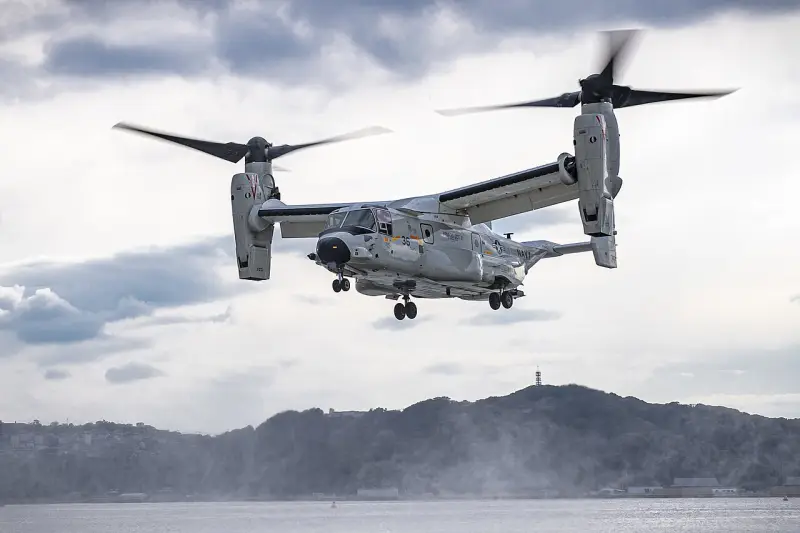
CMV-22B tiltrotor in flight
Several years ago, the US Navy decided to purchase CMV-22B tiltrotors to solve transport problems and supply ships at sea. This equipment was brought to the stage of initial operational readiness, but further progress was in question. Despite all efforts, the condition of the CMV-22B fleet leaves much to be desired, and its operation is associated with some restrictions and even risks.
Modern replacement
Since the mid-sixties, the task of transferring cargo and people from shore to an aircraft carrier has been solved with the help of C-2 Greyhound military transport aircraft developed by Grumman. These vehicles could carry more than 4,5 tons of cargo or up to 26 passengers over a range of up to 2400 km. The design of the aircraft ensured landing and takeoff from the deck of an aircraft carrier.
In 2009, it was proposed to abandon the obsolete C-2 and replace it with a modern model. The Bell/Boeing V-22 Osprey tiltrotor was proposed as such a replacement. This vehicle did not require a full-size flight deck and could carry similar cargo over a greater distance. With its help, it would be possible to service both aircraft carriers and ships of other classes that have a standard helipad.
Despite the obvious benefits, the proposal to purchase the Osprey had not progressed beyond general discussions at that time. They returned to this idea only in the mid-2015s. Thus, at the beginning of 22, an agreement emerged between the Navy and the Marine Corps on the gradual introduction of new V-XNUMXs, gaining operating experience, etc. According to initial calculations, the fleet 48 new tiltrotors were required. Subsequently, the required fleet was reduced to 44 units.
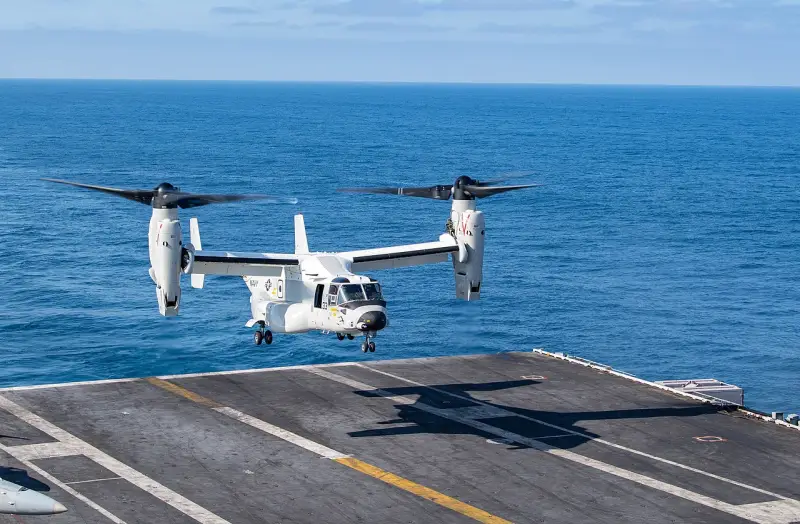
A CMV-22B lands on the aircraft carrier USS George HW Bush (CVN-77), March 2023.
In mid-2018, Boeing received an order to modify the existing V-22 to meet the requirements of the fleet and to subsequently launch mass production. The first document provided for the release of 39 units. new technology. In the same year, construction payments began. Until FY2020 inclusive, the military budget annually included the purchase of four vehicles. Subsequently, production rates increased.
The construction of production vehicles, which received the naval designation CMV-22B, started in 2018. The first aircraft were delivered to the customer in 2020. Subsequently, production and transfer of equipment continued. Due to the limited pace of construction, the series has not yet been completed, and deliveries should continue for several more years.
Convertiplanes in operation
The first CMV-22B products hit the naval Aviation Pentagon in 2020 and joined Logistics Squadron VRM 30 for pilot training and additional training. At the end of 2021, the unit reached the stage of initial operational readiness. It was assumed that the squadron would receive all standard equipment and reach full operational readiness in 2023.
Summer 2021, i.e. Even before reaching initial readiness, three CMV-22Bs from the first squadron went on their first mission. They were assigned to the aircraft carrier USS Carl Winson (CVN-70). During deployment and combat service, tiltrotors had to take on a significant part of the transport tasks and confirm their capabilities.
It should be noted that recent years have not been the most successful for the entire V-22 Osprey family. So, in June 2022, the KMP lost one of its MV-22 tiltrotors. The cause of the disaster was a transmission failure. In August, a similar breakdown occurred in another aircraft, but it was able to land. In both cases, flights of the entire tiltrotor fleet were suspended until the causes of the accident were clarified and the identified deficiencies were corrected.
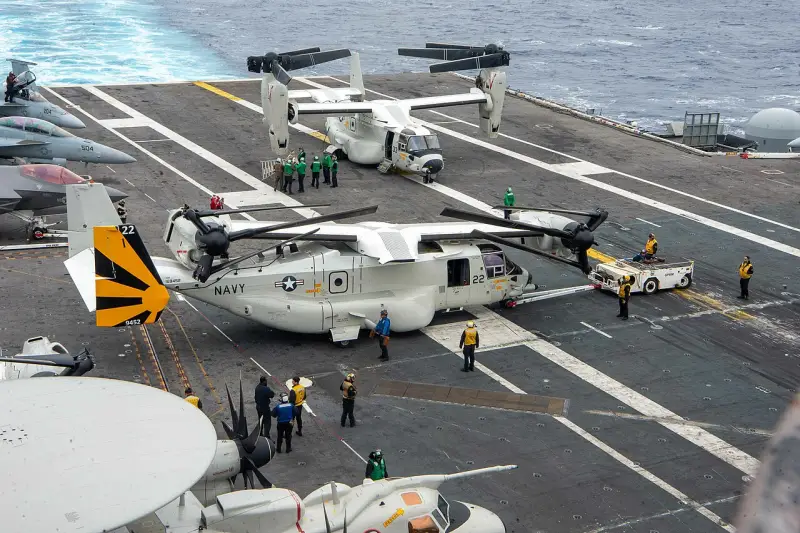
Convertiplanes on the aircraft carrier USS Carl Vinson (CVN-70)
It seems that it was not possible to correct all the shortcomings. In February 2023, flights had to be suspended again, and at the end of November 2023 there was another crash. This time, not only the United States, but also Japan stopped flights. All circumstances are being investigated and conclusions are being drawn up.
Regular problems with tiltrotors, which are few in number at that, have hit ship logistics. The US Navy command had to change the schedule for the decommissioning of C-2 aircraft, as well as additionally prepare such aircraft for continued service.
official paper
The production and use of CMV-22B tiltrotors is overseen by the Office of the Director of Operations, Test and Evaluation (DOT&E) at the Pentagon. A few days ago, it released a short public report on the Navy's operation of the Osprey last fiscal year. Overall, DOT&E reaches negative conclusions that require immediate action.
DOT&E reminds us that numerous design deficiencies and operational issues were identified as early as 2022. Almost all tiltrotor systems and mechanisms regularly fail and break down, which creates risks for equipment and people. A kind of record was set by the anti-icing system, which failed in 44% of cases of use. For naval aviation, this disadvantage is quite serious.
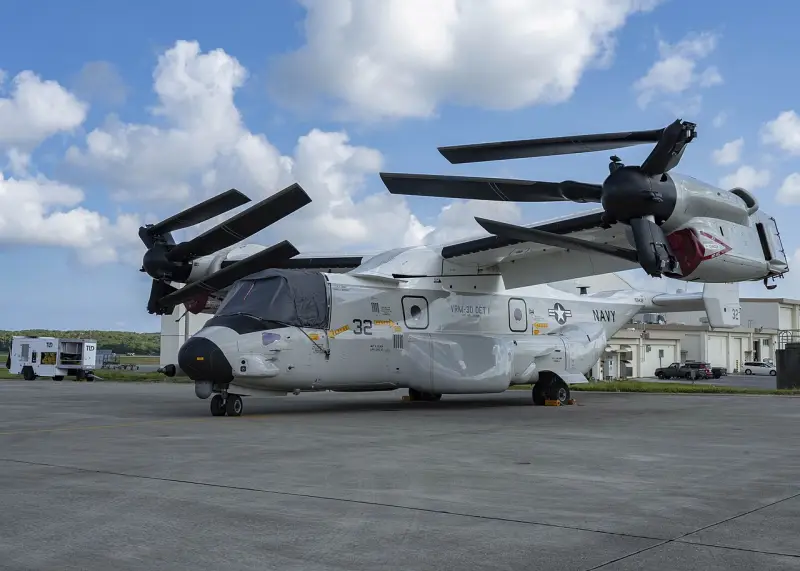
CMV-22B in parked configuration
Problems with equipment negatively affect the maintenance and operation process as a whole. According to DOT&E, the ratio of maintenance time to flight time is insufficient. At the same time, ok. 45% of the service comes from various additional activities and procedures. Their nature is not specified, but it can be assumed that they are associated with breakdowns and failures.
Previously, other features of the V-22 Osprey series tiltrotors were also criticized. In particular, ease of use is negatively affected by the lack of cabin sealing, which makes flying at high altitudes difficult and interferes with operation over the sea. In addition, due to the specific design, the machine is not easy to pilot.
DOT&E offers a number of measures to ensure full operation of equipment and reduce the likelihood of failures, incl. with negative consequences. First of all, this is the improvement of methods and means of training staff to improve the quality of service.
Marine version
The CMV-22B tiltrotor is a modification of the basic V-22 product, modified to meet the specific requirements of the naval forces. During its development, the finished airframe was almost completely preserved - with the exception of some modifications and measures related to operation over the sea. The power plant was also retained. At the same time, the avionics set was redesigned to meet new requirements.
The CMV-22B is built according to the design of a twin-rotor tiltrotor with rotating engine nacelles on a high wing. The fuselage has a traditional layout, and most of it is dedicated to the cargo-passenger cabin. Larger sponsons with increased capacity fuel tanks are mounted on the sides of the “marine” Osprey. In fact, this is its only external difference from other V-22 variants.
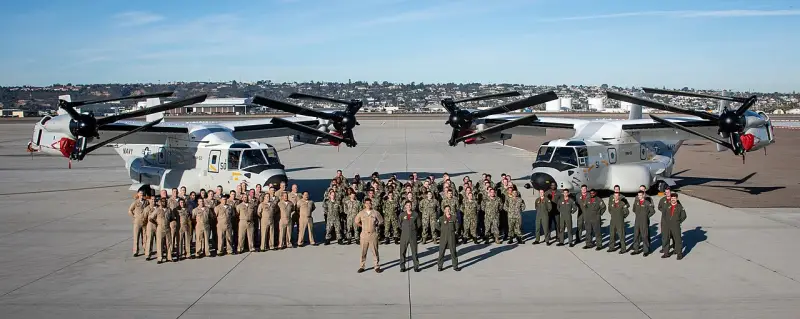
Tiltrotors and personnel of the VRM-50 squadron, December 2021.
The length of the vehicle reaches 17,5 m with a width (including the swept disks of two propellers) of 25,8 m. To reduce the parking dimensions, the propeller blades are folded and the wing rotates along the fuselage. Take-off weight – approx. 27,4 tons with a load of up to 9 tons. Two Rolls-Royce T406-AD-400 turboshaft engines with 6150 hp each. with three-blade main/traction propellers allow speeds of more than 500 km/h. Flight range with payload is up to 1700-1800 km.
The CMV-22B differs from other tiltrotors in its family in its set of radio-electronic equipment and cargo-passenger cabin equipment. Thus, it uses other radio stations with an increased range, including satellite communications. There is communication equipment of the Link 16 standard. The cargo compartment has a different lighting system and is equipped with an internal intercom.
Operating experience
The V-22 Osprey tiltrotor entered service in 2007, and the Marine Corps was the first to receive it. By the end of the decade, the air force began operating such equipment, and only in 2020 did tiltrotors of the new modification CMV-22B enter the combat units of the naval forces. To date, the three branches of the military have accumulated quite a lot of experience in operating the Osprey, and it cannot be called unambiguously positive. Tiltroplanes are criticized for the complexity of their design and operation, as well as for their low reliability and safety.
Recent reports from the United States show that the reliability and safety of the entire V-22 family remains an issue. Pentagon regulatory authorities are monitoring this situation and proposing measures to correct it. The future of the Navy’s tiltrotor aircraft and the logistics of ship units in general depends on how effective such measures will be.
Information